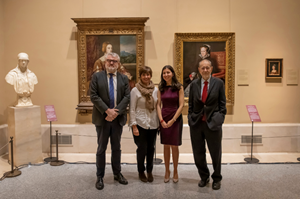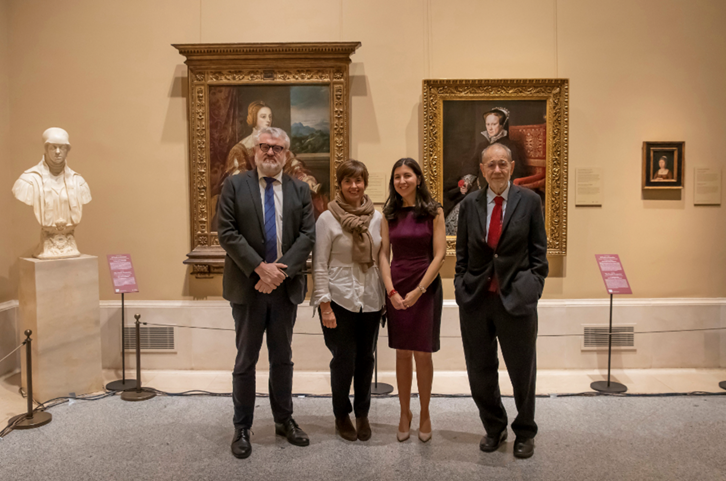
In collaboration with the Ministry of Culture’s Institute for Women, the Museo Nacional del Prado is offering a new perspective on its permanent collection through a thematic route devised with the academic supervision of Noelia García Pérez, associate professor of art history at the University of Murcia.
In collaboration with the Ministry of Culture’s Institute for Women, from today until 9 April 2023 the Museo Nacional del Prado is offering a new perspective on its permanent collection through a thematic route devised with the academic supervision of Noelia García Pérez, associate professor of art history at the University of Murcia. The result is a fresh viewpoint and one that encourages us to focus on the role of women as promoters and patrons of the arts.
Among all European museums, the Prado is probably the one in which women have played the most decisive role with regard to its configuration, either as collectors and promoters or through their key contribution to its foundation and existence. Works such as Van der Weyden’s Descent from the Cross, Titian’s Charles V at the Battle of Mühlberg, the superb bronze sculptures of Philip II and Mary of Hungary commissioned from Pompeo and Leone Leoni, and The Holy Family with Saints by Rubens would not be present in the Prado’s collection without women’s involvement.
The works included in this thematic route are associated with women who were not only notable for their activities as patrons but also in the promotion of the artists who worked in their service. One particularly notable example is that of Isabel Clara Eugenia. The Prado houses dozens of works directly resulting from her patronage, in addition to the fact that the Museum’s close connections with Rubens is particularly allied to the promotion and dissemination of his career on the part of the Archduchess, who was governor of the Southern Netherlands. This explains why the Prado houses the largest collection of works by Rubens in the world.
 From left to right: Miguel Falomir, Director of the Museo Nacional del Prado; Marina Chinchilla, Deputy Management Director of the Museo Nacional del Prado; Noelia García Pérez Art History Professor at the Universidad de Murcia and Javier Solana, Head of the Board of Trustees of the Museo Nacional del Prado during the press conference of the itinerary “The Female Perspective”. Photo © Museo Nacional del Prado
From left to right: Miguel Falomir, Director of the Museo Nacional del Prado; Marina Chinchilla, Deputy Management Director of the Museo Nacional del Prado; Noelia García Pérez Art History Professor at the Universidad de Murcia and Javier Solana, Head of the Board of Trustees of the Museo Nacional del Prado during the press conference of the itinerary “The Female Perspective”. Photo © Museo Nacional del Prado
“The Female Perspective” reflects the first edition of the symposium “Key Women in the creation of the Prado’s collections”, which took place in March this year and will be followed by “Key Women in the creation of the Prado’s collections II. From Elisabeth of France to Mariana of Neuburg”, to be held on 6 and 7 March 2023.
The Museo Nacional del Prado’s thematic routes are devised with the aim of encouraging a fresh viewpoint. With this proposal in mind they regularly count on the collaboration of external experts working in disciplines other than those normally associated with the Museum. The intention is thus to foster a different but rigorous perspective on the collections, focusing on themes and subjects other than the habitual ones, in this case making women the centre of attention.
This is the case with “The Female Perspective”, an important and topical route devised with the academic supervision of Professor Noelia García Pérez. Through 32 works it draws our attention to the women who commissioned, collected or inspired some of the most important works of art in the Museum’s collection.
As such, the route encourages us to explore new narratives and discover unique and surprising accounts in which women are subjects in their own right: artistic promoters, patrons of the arts, the women who lie behind the Museo del Prado and who made such a vital contribution to the formation of its collections during a specific chronological timespan, from 1451 to 1633, in other words the lifetimes of Isabella the Catholic to Isabel Clara Eugenia.
The creation of this route has also provided the opportunity to display various works that were previously in storage at the Museum, including the portraits of Isabel Clara Eugenia and Albert of Austria by Rubens and Jan Brueghel the Elder; John Frederick of Saxony by Titian; Elisabeth of Valois by Pantoja de la Cruz; and Anne of Austria by Bartolomé González. In addition, other works have been relocated in the galleries, including the sculptural busts of Eleanor of Austria and Mary of Hungary by Dubroeucq and the Leonis respectively, in order to offer a more complete narrative of the permanent collection. Finally, the titles and texts of some of the labels that accompany works on display have been modified to offer an account that better reflects 21st-century interests.
In association with this new route, the Museo del Prado has produced three documentaries corresponding to the three sections. Experts from the Prado and from other museums and academic institutions have participated in these audiovisual productions, which can undoubtedly be seen as an extremely valuable resource for understanding who these women were and the nature of their activities as artistic promoters. Available on the Museum’s Youtube channel, these videos constitute an exceptionally useful resource in terms of knowledge transfer and academic dissemination.
With the aim of introducing us to these women, to the nature of their activities in relation to artistic promotion and to their connection with the Prado’s collections, this new thematic route starts with a section entitled “Women patrons of art in the Museo del Prado (1451-1633)”. It focuses on the most important portraits of these queens, regents and governors on display in the permanent collection, works that reveal the iconographic solutions and visual strategies used to construct and promote the public image of the sitters while simultaneously revealing the mechanisms that legitimised women in the exercise of power. These portraits allow us to explore the uses and functions assigned to them by focusing our gaze on the issues of religious devotion, ties of family affection, political ambition and personal glory which underlie the patronage that brought them into existence.
The second and third sections are devoted to the two most important women art patrons of this period associated with the Museum’s collections, namely Mary of Hungary and Isabel Clara Eugenia, both of whom held extremely prominent political positions. After the death of her husband Louis II, Mary was regent of Hungary in the name of her brother Ferdinand I until June 1527 then governor of the Southern Low Countries from 1531 to 1555. Isabel Clara Eugenia was sovereign princess of the latter territories from 1599 to 1621, ruling jointly with her husband the Archduke Albert, after which she was sole governor as a widow until her death in 1633. Both Mary and Isabel took full advantage of their prominent political positions and the autonomy their status as widows allowed them to consolidate their authority and maintain their networks of influence while also creating two of the most important art collections of the European Renaissance. In this sense it should be noted that some of the works of art and architectural projects that they commissioned were particularly useful for defining their roles and positions at court while simultaneously projecting them on the international political stage.
The selection of devotional works, mythological scenes and portraits of overtly political intent included in these two sections allows us to learn more about two of the key figures in European politics of the Early Modern age who were also two of the most important art patrons of the period. RDF

ArtDependence Magazine is an international magazine covering all spheres of contemporary art, as well as modern and classical art.
ArtDependence features the latest art news, highlighting interviews with today’s most influential artists, galleries, curators, collectors, fair directors and individuals at the axis of the arts.
The magazine also covers series of articles and reviews on critical art events, new publications and other foremost happenings in the art world.
If you would like to submit events or editorial content to ArtDependence Magazine, please feel free to reach the magazine via the contact page.